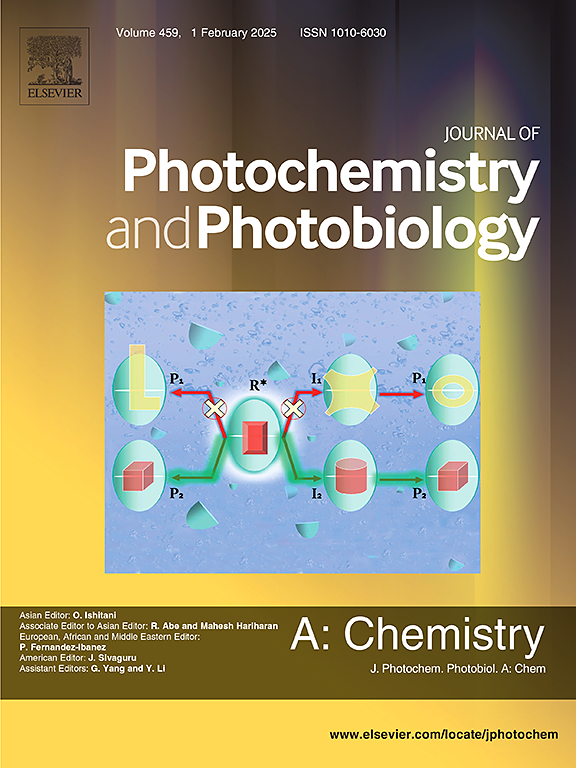利用还原氧化石墨烯修饰氧化铜纳米复合材料高效降解阿莫西林抗生素
IF 4.1
3区 化学
Q2 CHEMISTRY, PHYSICAL
Journal of Photochemistry and Photobiology A-chemistry
Pub Date : 2025-04-07
DOI:10.1016/j.jphotochem.2025.116438
引用次数: 0
摘要
药物污染物已成为世界范围内水资源污染的主要来源,人们日益认识到它们对健康和环境的深远影响。因此,开发高效、经济、可持续的方法去除或降解水中的这些污染物是至关重要的。本文制备了氧化铜修饰的还原氧化石墨烯纳米片,用于光催化降解水中的阿莫西林(AMX)抗生素。采用XRD、SEM、EDX和AFM等分析手段对制备的氧化石墨烯-氧化铜纳米复合材料的结构和形貌进行了表征。这些研究表明,制备的纳米复合材料具有平均尺寸为25 nm的晶体结构,元素纯度高,形貌粗糙。将合成的氧化石墨烯-氧化铜纳米复合光催化剂进一步用于AMX抗生素的降解。通过优化催化剂用量(0.8 mg)、质子源浓度(0.003 M)和光照时间(10 min)等关键实验参数,AMX的降解率达到了98.7%。这一显著的结果突出了rGO-CuO纳米复合材料优异的光催化性能。此外,经优化后制备的rgo - cuo基光催化剂可以大规模有效地降解其他抗生素。本文章由计算机程序翻译,如有差异,请以英文原文为准。
Efficient Visible-Light-Driven degradation of amoxicillin antibiotic using reduced graphene oxide decorated copper oxide nanocomposite materials
Pharmaceutical contaminants have become a major source of pollution in water resources worldwide, with growing awareness of their profound health and environmental consequences. Therefore, the development of efficient, cost-effective, and sustainable methods for removing or degrading these pollutants from water is essential. Herein, the reduced graphene oxide nanosheets decorated with copper oxide (rGO-CuO) nanocomposite was prepared for the effective photocatalytic degradation of amoxicillin (AMX) antibiotic in water. The structural and morphological properties of the prepared rGO-CuO nanocomposite were thoroughly investigated using XRD, SEM, EDX, and AFM analyses. These studies showed that the as-prepared nanocomposite has a crystalline structure having the average size of 25 nm with high elemental purity and rough morphology. The synthesized rGO-CuO nanocomposite photocatalyst was further employed for the degradation of AMX antibiotic. By optimizing key experimental parameters, such as catalyst dosage (0.8 mg), proton source concentration (0.003 M), and sunlight exposure duration (10 min), an exceptional 98.7 % degradation of AMX was achieved. This remarkable outcome highlights the excellent photocatalytic performance of the rGO-CuO nanocomposite. Moreover, the as-prepared rGO-CuO-based photocatalyst can be effective at large-scale for the degradation of other antibiotics after optimization.
求助全文
通过发布文献求助,成功后即可免费获取论文全文。
去求助
来源期刊
CiteScore
7.90
自引率
7.00%
发文量
580
审稿时长
48 days
期刊介绍:
JPPA publishes the results of fundamental studies on all aspects of chemical phenomena induced by interactions between light and molecules/matter of all kinds.
All systems capable of being described at the molecular or integrated multimolecular level are appropriate for the journal. This includes all molecular chemical species as well as biomolecular, supramolecular, polymer and other macromolecular systems, as well as solid state photochemistry. In addition, the journal publishes studies of semiconductor and other photoactive organic and inorganic materials, photocatalysis (organic, inorganic, supramolecular and superconductor).
The scope includes condensed and gas phase photochemistry, as well as synchrotron radiation chemistry. A broad range of processes and techniques in photochemistry are covered such as light induced energy, electron and proton transfer; nonlinear photochemical behavior; mechanistic investigation of photochemical reactions and identification of the products of photochemical reactions; quantum yield determinations and measurements of rate constants for primary and secondary photochemical processes; steady-state and time-resolved emission, ultrafast spectroscopic methods, single molecule spectroscopy, time resolved X-ray diffraction, luminescence microscopy, and scattering spectroscopy applied to photochemistry. Papers in emerging and applied areas such as luminescent sensors, electroluminescence, solar energy conversion, atmospheric photochemistry, environmental remediation, and related photocatalytic chemistry are also welcome.

 求助内容:
求助内容: 应助结果提醒方式:
应助结果提醒方式:


